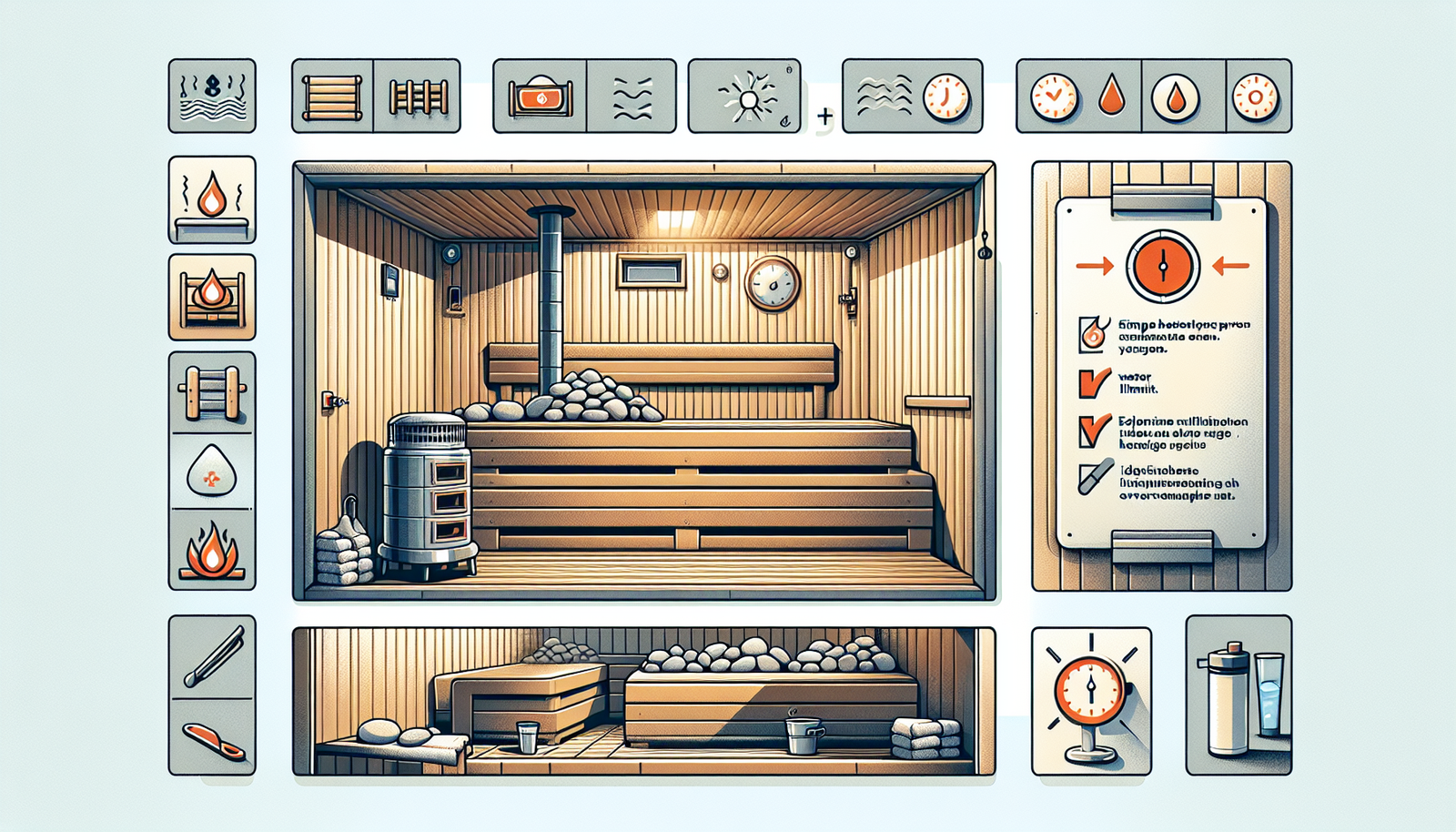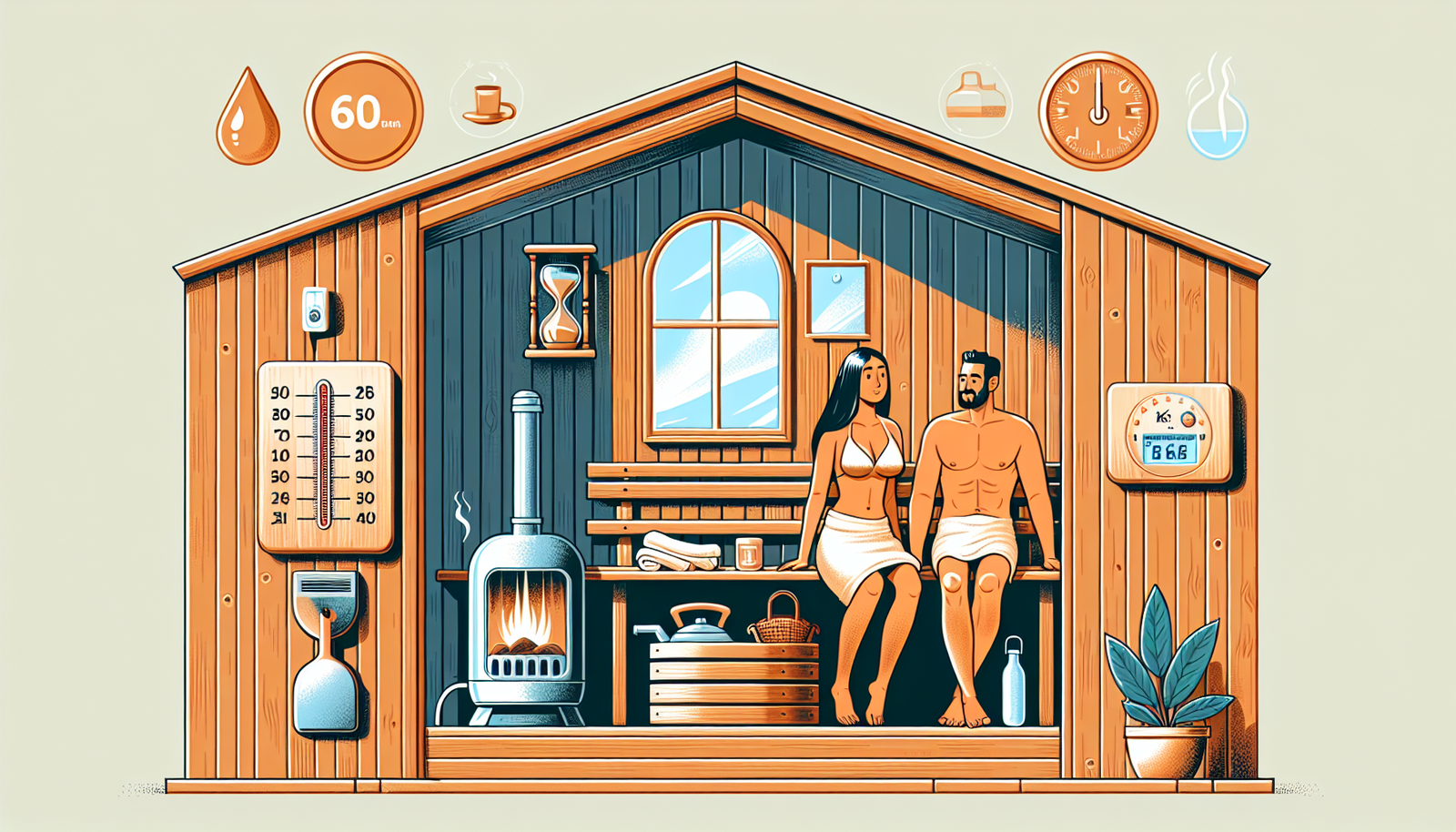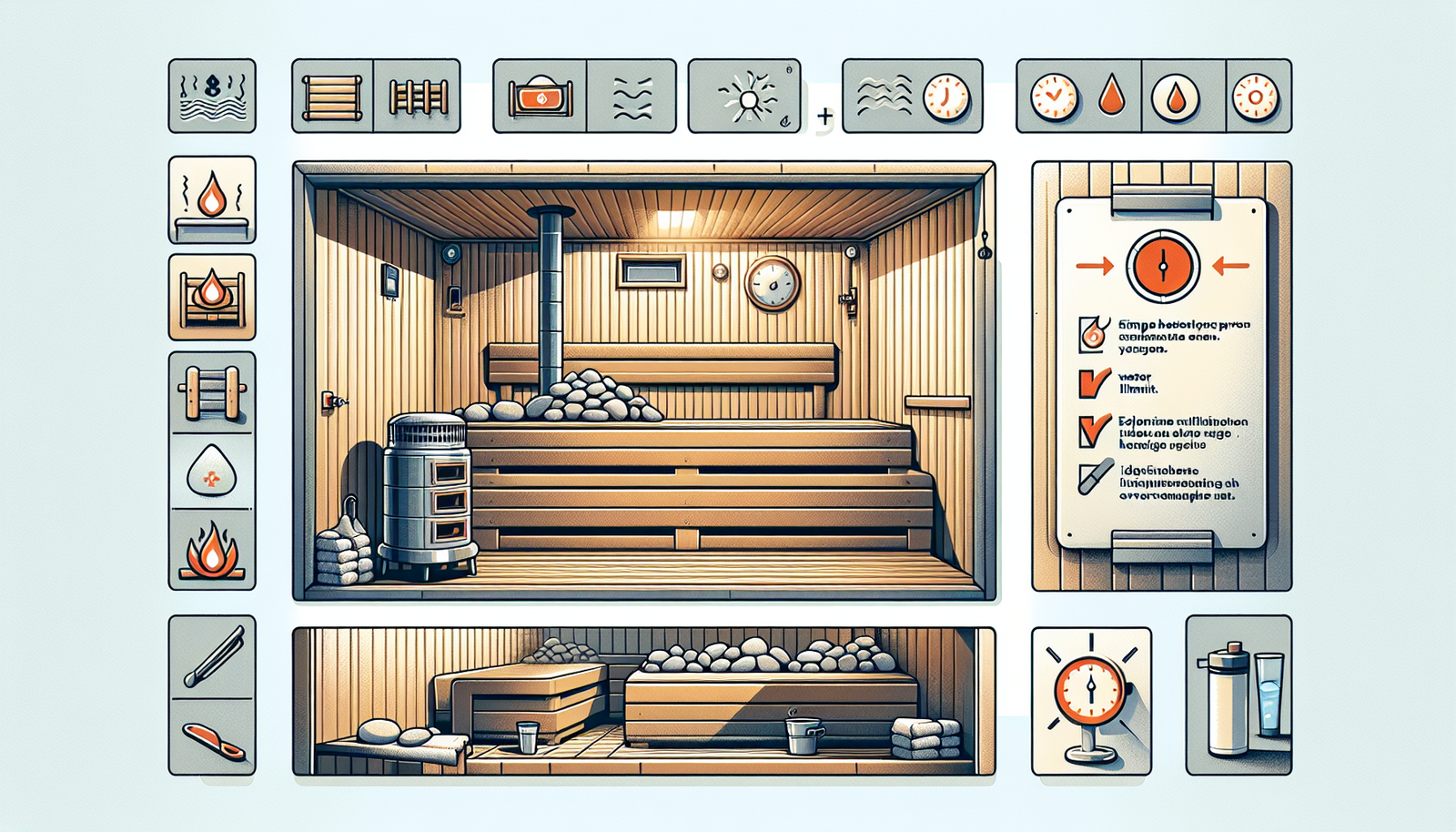Imagine stepping into a traditional sauna, the air thick with heat and relaxation beckoning from every pore of the room. While the experience promises immense rejuvenation, it’s important to remember that excessive heat exposure carries the risk of overheating. So, how can you ensure a safe and enjoyable sauna experience without pushing your limits? This article explores practical tips to keep you cool and comfortable during your next sauna session, helping you make the most of this ancient therapeutic practice while prioritizing your well-being.

Proper Sauna Design
Ventilation System
A well-designed sauna should have a proper ventilation system in place to ensure adequate airflow. Ventilation is essential to remove excess heat and humidity from the sauna room, creating a comfortable environment for you to enjoy your sauna session. Without proper ventilation, the sauna can quickly become stifling and unpleasant. It is recommended to have both an intake vent and an exhaust vent to establish a steady flow of fresh air.
Insulation
To maintain optimal heat retention and energy efficiency in your sauna, proper insulation is key. Good insulation prevents heat loss and ensures that the sauna room heats up quickly and stays warm throughout your session. Insulating the walls, ceiling, and floor with suitable materials such as foil-backed insulation boards or mineral wool can help create a cozy sauna experience.
Proper Door and Window Seals
Another crucial element of a well-designed sauna is having proper door and window seals. Well-sealed doors and windows prevent heat from escaping the sauna, maintaining the desired temperature and ensuring an effective sauna session. It is important to regularly check and maintain the seals to ensure their effectiveness. If you notice any gaps or air leaks, make sure to seal them promptly to avoid heat loss.
Temperature and Time Control
Set a Reasonable Temperature
When using a traditional sauna, it is essential to set a reasonable temperature that suits your comfort level. Optimal sauna temperatures typically range between 70 to 90 degrees Celsius (160 to 195 degrees Fahrenheit). Start at a lower temperature and gradually increase it to avoid overheating. Remember, the goal is to create a relaxing and enjoyable experience, so find the temperature that feels best for you.
Use a Timer
Using a timer is crucial for regulating the duration of your sauna sessions. It is recommended to start with shorter sessions, such as 10-15 minutes, especially if you are new to sauna bathing. As you acclimatize, you can gradually increase the time to a maximum of 30 minutes per session. Setting a timer ensures that you do not unintentionally overextend your time in the sauna, which can lead to dehydration and other potential health risks.
Limit Session Duration
While sauna sessions can offer immense health benefits, it is crucial to limit the duration of each session. Prolonged exposure to high temperatures can result in overheating and dehydration, so it is recommended to keep each session within a safe timeframe. Aim for 15 to 30 minutes per session, focusing on gradual progress rather than extended periods of time in the sauna.
Hydration
Drink Plenty of Water
Staying hydrated is of utmost importance when using a sauna. The heat and perspiration during a sauna session can lead to significant fluid loss in your body. To prevent dehydration, it is essential to drink plenty of water before, during, and after your sauna session. Make sure to have a bottle of water nearby and take small sips regularly to replenish the lost fluids.
Avoid Alcohol and Caffeine
While it may be tempting to enjoy a cold beer or a cup of coffee before or after your sauna session, it is best to avoid alcohol and caffeine. Both alcohol and caffeine can dehydrate your body even further, which can be dangerous when combined with the heat of the sauna. Opt for water or herbal tea instead to complement your sauna experience.
Take Breaks to Rehydrate
In addition to drinking water throughout your sauna session, it is also beneficial to take breaks to rehydrate. Step outside the sauna room briefly to cool down and drink some water before resuming your session. This allows your body to replenish fluids and maintain a healthy balance. Listen to your body’s signals, and if you feel lightheaded or dizzy, take a break and hydrate before continuing.
Sauna Clothing and Accessories
Choose Light and Breathable Clothing
When it comes to sauna clothing, less is more. Opt for light and breathable clothing or even go nude if you feel comfortable. The purpose is to allow your body to sweat and release toxins effectively. Avoid heavy clothing or materials that can trap heat, as this can lead to discomfort and overheating. Remember, the sauna experience is about relaxation, so choose clothing that promotes comfort.
Use a Towel or Sauna Mat
To prevent direct contact with the hot sauna benches or floor, it is advisable to use a towel or sauna mat. This not only provides a barrier between you and the heated surfaces but also absorbs excess sweat. The towel or mat can be placed on the bench or floor before your sauna session to enhance your comfort and maintain cleanliness.

Monitoring Humidity Levels
Use a Hygrometer
To ensure an optimal sauna experience, it is essential to monitor the humidity levels inside the sauna. A hygrometer is a device used to measure humidity, and having one in your sauna can help you maintain the perfect balance. The ideal humidity level for a traditional sauna is typically between 10% and 20%. Monitoring the humidity ensures that you are not exposed to excessive moisture, which can impact your comfort and overall sauna experience.
Maintain Proper Humidity Levels
Properly maintaining humidity levels in a sauna is crucial for both comfort and safety. If the humidity is too low, you may experience dryness and discomfort, while excessive humidity can make the sauna feel suffocating. To adjust humidity levels, you can add water to the sauna rocks or use a water source such as a ladle. Experimenting with the amount of water added can help you find the humidity level that suits you best.
Sauna Etiquette and Behavior
Avoid Overcrowding
Sauna sessions are meant to be a peaceful and relaxing experience, so it is important to respect the personal space of others. Do not overcrowd the sauna by bringing in more people than it can comfortably accommodate. Overcrowding can make the sauna uncomfortably hot and prevent others from enjoying their session. If the sauna is too crowded, consider waiting for your turn or finding another time when it is less busy.
Respect Other Sauna Users
In addition to avoiding overcrowding, it is essential to respect the privacy and comfort of other sauna users. Keep your conversations low and avoid loud noises that can disturb others. Remember that the sauna is a place for relaxation and tranquility, so be mindful of the atmosphere and act accordingly. Being considerate of others’ space and quiet enjoyment will create a harmonious sauna environment for everyone.
Do Not Overexert Yourself
While sauna sessions offer numerous health benefits, it is important to listen to your body and not overexert yourself. Pay attention to how you feel during the session and take breaks if needed. If you start feeling dizzy, lightheaded, or experience any discomfort, it is essential to exit the sauna immediately and cool down. Pushing yourself beyond your comfort limits can lead to overheating and potential health risks.
Gradually Acclimatizing Your Body
Start with Short Sessions
If you are new to the sauna, it is wise to start with shorter sessions and gradually increase the duration. This allows your body to adjust to the heat and prevent overheating or discomfort. Begin with 5 to 10-minute sessions and gradually extend them as you become more accustomed to the heat. It is important to listen to your body and progress gradually to ensure a safe and enjoyable sauna experience.
Increase Temperature and Session Duration Gradually
Similar to acclimatizing the duration, it is essential to gradually increase the temperature of your sauna sessions. Starting at a lower temperature and slowly increasing it over time allows your body to adjust to the heat more effectively. Additionally, increasing the session duration gradually allows your body to adapt and reap the full benefits of the sauna experience without putting unnecessary stress on your system.
Frequency of Sauna Sessions
Avoid Frequent Back-to-Back Saunas
While sauna sessions can be highly beneficial, it is important to avoid frequent back-to-back sessions. Your body needs time to recover and replenish its resources after each sauna session. It is recommended to leave at least a day or two between sauna sessions to allow your body to rest and restore its natural balance. Consistency is key, but it is equally essential to give yourself proper recovery time between sessions.
Allow Sufficient Time for Recovery
Each person’s body is unique, and the recovery time needed after a sauna session may vary. Pay attention to how you feel after each session and give yourself sufficient time to recover before having another sauna session. If you feel fatigued or notice any signs of overexertion, listen to your body and take a break. Sauna sessions should enhance your well-being, not deplete it, so prioritize rest and recovery.
Avoiding Sauna During Illness or Medication
Consult with a Physician
If you are currently under medication or have a pre-existing medical condition, it is crucial to consult with your physician before using a sauna. Certain medications and health conditions can interact negatively with high temperatures and humidity. Your doctor can provide guidance on whether sauna bathing is safe for you and offer specific recommendations based on your individual circumstances.
Do Not Use Sauna if Febrile or Under Medication
It is advisable to avoid using a sauna if you are febrile or running a high temperature. The added heat from the sauna can further elevate your body temperature and potentially worsen your symptoms. Additionally, if you are taking medications that make you more susceptible to dehydration or dizziness, it is best to refrain from sauna use. Safety should always come first, so prioritize your health and well-being above all else.
Identifying Warning Signs
Fatigue, Dizziness, or Faintness
While sauna sessions have numerous benefits, it is important to be aware of warning signs that indicate you may be overexerting yourself. If you start feeling excessively fatigued, dizzy, or faint, it is crucial to exit the sauna immediately and cool down. These symptoms typically indicate that your body is unable to handle the heat and needs to regulate its temperature. Listen to your body and prioritize your safety.
Headache or Nausea
If you experience a headache or nausea during your sauna session, it is recommended to exit the sauna and cool down. These symptoms can be signs of dehydration, overheating, or a reaction to the high temperature. Give yourself time to hydrate and rest before considering another sauna session. Pay attention to your body’s signals, and if these symptoms persist, it is advisable to seek medical attention.
Sudden Drop in Blood Pressure
A sudden drop in blood pressure can occur when transitioning from a hot environment, such as a sauna, to a cooler environment. If you experience lightheadedness or a rapid drop in blood pressure after leaving the sauna, take your time and allow your body to adjust gradually. Slowly sit or lie down and drink water to prevent fainting or potential injuries. It is important to give your body time to stabilize before moving or standing up quickly.
By following these guidelines for proper sauna design, temperature control, hydration, clothing, monitoring humidity levels, sauna etiquette, acclimatization, frequency of sauna sessions, and avoiding sauna use during illness or medication, you can ensure a safe and enjoyable sauna experience. Remember, the sauna is a place for relaxation and rejuvenation, so prioritize your well-being and listen to your body’s needs. Enjoy the benefits of sauna bathing while maintaining a healthy and balanced approach.

